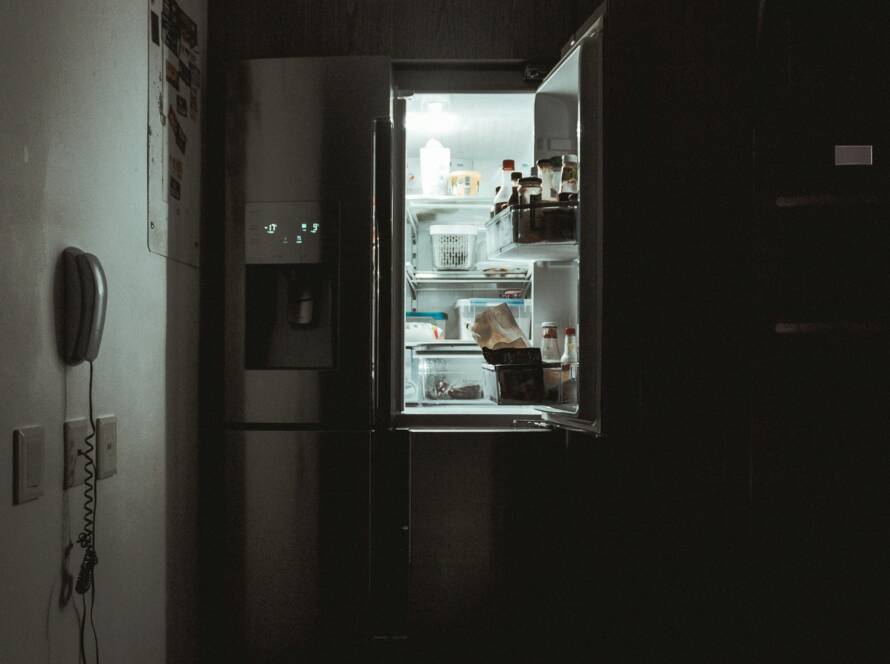You arrive at work Monday morning to find your walk-in cooler has failed over the weekend. Thousands of pounds worth of food has spoiled. You can’t open for business. Your customers are disappointed, and your reputation takes a hit. This nightmare scenario happens to restaurants every single day, but it’s completely preventable.
The Real Cost of Food Storage Failures
Food safety isn’t just about following health department rules – it’s about protecting your business from devastating losses. When food storage goes wrong, the consequences are immediate and expensive.
Lost inventory. A typical restaurant walk-in cooler holds £2,000-£5,000 worth of food. When storage fails, that inventory becomes worthless overnight. For many restaurants, this represents days or weeks of profit.
Forced closures. Health inspectors can shut you down immediately if they find food stored at unsafe temperatures. Every day you’re closed means lost revenue and customers who might not return.
Food poisoning lawsuits. When customers get sick from contaminated food, the legal costs can be devastating. Even a single food poisoning incident can cost tens of thousands in legal fees and settlements.
Reputation damage. Word spreads quickly when a restaurant causes food poisoning. In the age of social media and online reviews, one food safety incident can destroy years of reputation building.
Insurance problems. Multiple food safety claims can drive up your premiums or even get your coverage cancelled entirely.
How Food Storage Fails Without Warning
Restaurant refrigeration faces constant challenges that can lead to dangerous temperature fluctuations:
Equipment wear and tear. Coolers and freezers work hard in busy kitchens. Compressors fail, seals deteriorate, and temperature controls malfunction. Most failures happen gradually, making them hard to detect until it’s too late.
Human error. Staff accidentally leave doors open, overfill units, or place hot food in coolers before it’s properly cooled. In busy kitchens, these mistakes are almost inevitable.
Power outages. Extended power losses can spoil entire inventories. Even short outages can cause temperature spikes that make food unsafe.
Maintenance neglect. Dirty coils, worn door seals, and other maintenance issues make refrigeration units work harder and fail more often.
Temperature danger zones. Food becomes unsafe when stored between 40°F and 140°F. In this range, bacteria multiply rapidly – doubling every 20 minutes. What starts as a minor temperature increase can become a major safety hazard within hours.
The Cost of Traditional Food Safety Methods
Most restaurants still rely on outdated monitoring methods that often fail when you need them most:
Manual temperature logs. Staff walk around with thermometers several times daily, recording temperatures on paper. This only shows what’s happening at that exact moment – not overnight or between checks.
Basic alarms. Simple systems beep when temperatures rise, but only if someone’s there to hear them. Night and weekend failures go unnoticed until it’s too late.
Visual inspections. Staff look for signs of spoilage, but food can be dangerous long before it looks or smells bad.
Hope and prayer. Many restaurants simply hope their equipment keeps working. This isn’t a strategy – it’s gambling with your business.
Smart Monitoring: Protection That Never Sleeps
Companies like SmartSenser have developed monitoring systems that watch your food storage around the clock. Think of it as having a food safety expert who never takes breaks, never forgets to check, and alerts you instantly when problems arise.
Continuous monitoring. Sensors measure temperature and humidity in every cooler and freezer every few minutes. Unlike human checkers, these systems never get distracted or forget to check critical areas.
Instant alerts. When temperatures drift outside safe ranges, the system immediately notifies managers via text, email, or phone calls. Problems get caught within minutes instead of hours or days.
Remote access. Check on your food storage from anywhere using your smartphone. Whether you’re at home, on holiday, or managing multiple locations, you stay connected to your operation.
Historical data. Track temperature patterns over time to identify equipment problems before they cause failures. This helps you schedule maintenance proactively instead of reactively.
Documentation. Automatic records prove to health inspectors that you maintain proper food temperatures. This can help you pass inspections and demonstrate compliance.
Real Restaurant Success Stories
The weekend save. A burger restaurant installed smart monitoring just before a busy summer weekend. Saturday night, their main cooler started failing. The system immediately alerted the manager, who called repair services. They fixed the problem within hours, saving £3,000 worth of food and avoiding a weekend closure.
The silent failure prevention. A family restaurant’s freezer compressor was gradually failing over several days. Traditional monitoring would have missed this slow deterioration. Smart sensors detected the gradual temperature rise and alerted management before any food spoiled.
The holiday protection. During Christmas break, a restaurant’s walk-in cooler door wasn’t closing properly. Smart monitoring alerted the owner, who was out of town. He called his assistant manager to fix the door, preventing thousands of pounds in spoiled holiday inventory.
The insurance discount. A restaurant chain negotiated lower insurance premiums after installing smart monitoring across all locations. The insurer recognized that monitored restaurants have fewer food safety claims.
How Smart Monitoring Works in Practice
Wireless sensors install easily in every food storage area. They’re about the size of a smoke detector and don’t interfere with daily operations.
Cloud-based monitoring analyzes all temperature data and identifies problems immediately. The system learns your restaurant’s normal patterns and alerts you when something unusual happens.
Multiple alert channels ensure you get notified. The system might text your manager, email the owner, and call the head chef simultaneously.
Easy-to-use dashboard shows all your food storage information in one place. Staff can quickly verify that everything’s working properly and review historical data.
Integration with existing equipment means you don’t need to replace your current refrigeration systems. Smart monitoring works with whatever equipment you already have.
The Business Case for Smart Monitoring
Cost prevention. Smart monitoring typically costs less than a single major food spoilage incident. One prevented disaster can pay for years of monitoring.
Reduced labor costs. Automated monitoring eliminates the need for manual temperature checks, freeing up staff for customer service and other important tasks.
Insurance savings. Many insurers offer discounts for restaurants with professional monitoring systems, recognizing their lower risk profiles.
Improved efficiency. Early detection of equipment problems allows for scheduled maintenance instead of emergency repairs, which are typically more expensive.
Competitive advantage. Restaurants with advanced food safety systems can advertise this fact to attract health-conscious customers.
Implementation: Easier Than You Think
Assessment. Smart monitoring companies evaluate your current setup and recommend the best sensor placement for comprehensive coverage.
Installation. Wireless sensors install quickly without disrupting operations. Most systems can be up and running within hours.
Training. Staff learn to use the monitoring dashboard and respond to alerts. The systems are designed to be user-friendly and intuitive.
Ongoing support. Professional monitoring services provide continuous oversight and technical support to ensure optimal performance.
Immediate Steps Every Restaurant Should Take
While planning for smart monitoring, you can improve food safety immediately:
- Check temperatures manually at least three times daily, including opening and closing
- Train all staff on proper food storage procedures and temperature requirements
- Maintain equipment regularly – clean coils, check door seals, and schedule professional servicing
- Establish backup procedures for equipment failures, including emergency repair contacts
- Document everything – keep detailed temperature logs for health inspectors
The Future of Food Safety
Technology continues to advance, offering even better protection:
Predictive maintenance systems that warn you when equipment is likely to fail, allowing you to schedule repairs before problems occur.
Individual item tracking that monitors the temperature history of specific food items from delivery to service.
Integration with inventory systems that automatically tracks how long food has been stored and alerts staff when items approach expiration.
AI-powered optimization that learns your restaurant’s patterns and automatically adjusts storage conditions for maximum safety and efficiency.
Your Next Steps
Food safety should never be left to chance. Every day without proper monitoring puts your restaurant at risk of devastating losses.
Evaluate your current protection:
- How often do you check temperatures?
- What backup systems do you have for equipment failures?
- Can you monitor food storage remotely?
Calculate your risk:
- What’s the value of food in your storage areas?
- How much would a forced closure cost per day?
- What would a food poisoning lawsuit cost?
Consider smart monitoring:
- Compare the cost of monitoring to the cost of a single failure
- Look for systems that integrate with your existing equipment
- Choose providers with restaurant experience and 24/7 support
Contact SmartSenser:
- Get a customized assessment of your needs
- Learn about installation and ongoing costs
- Discuss how monitoring integrates with your current operations
Protecting Your Business and Your Customers
Food safety isn’t just about following regulations – it’s about protecting your livelihood and your customers’ health. Smart monitoring technology makes comprehensive food safety protection affordable and automatic.
The investment in professional monitoring pays for itself the first time it prevents a disaster. More importantly, it gives you confidence that your food is always safe, your customers are protected, and your business is secure.
Don’t wait for a food safety disaster to teach you an expensive lesson. The technology exists today to prevent almost every food storage failure, and it’s more affordable than you might think.
Your restaurant’s reputation took years to build. Smart food storage monitoring helps ensure that one equipment failure doesn’t destroy everything you’ve worked to create.
The choice is simple: invest in prevention or risk everything on hope. Smart monitoring makes that choice easy.


